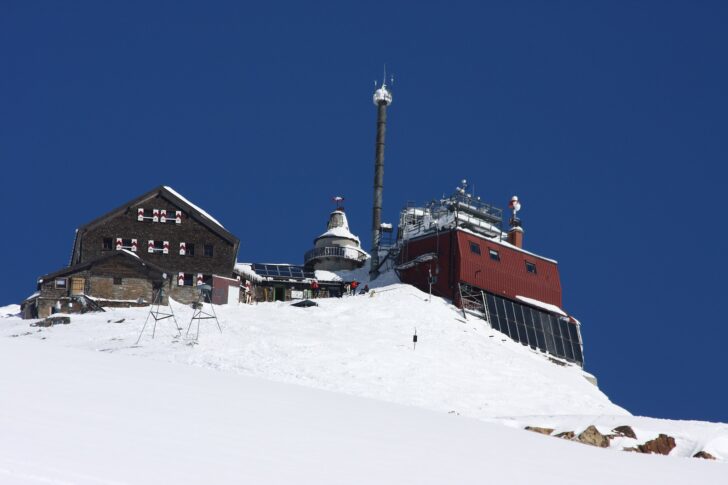New method shows: Alpine snow contains plastic

Nanoplastics in the environment: new chemical method developed to count plastic particles.
In a large-scale fundraising campaign, popular Youtubers such as Mister Beast and Mark Rober are currently trying to rid the oceans of almost 14’000 tons of plastic. That's about 0.15 percent of the amount that ends up in the oceans every year. But it's not just our waters that are full of plastic. A new study shows the spread of nanoplastics through the air is a more widespread problem than previously thought.
In a new study, Empa researcher Dominik Brunner, together with colleagues from Utrecht University and the Austrian Central Institute for Meteorology and Geodynamics, is investigating how much plastic is trickling down to us from the atmosphere. According to the study, nanoplastics sometimes travels more than 2’000 kilometers through atmospheric transport. According to the figures from the Austrian measurement, around 43 trillion fine plastic particles land in Switzerland every year. Researchers still disagree on the exact number. According to estimates from the study however, it could be as much as 3’000 tons of nanoplastics that cover Switzerland every year, from the remote Alps to the urban lowlands. These estimates are very high relative to other studies, and more research is needed to verify these values.
The study is uncharted scientific territory. That's because the dispersal of nanoplastics through the air remains largely unexplored. The result of Brunner's research is the most accurate record of air pollution from nanoplastics ever conducted. To count the plastic particles, Brunner and his colleagues have specially developed a chemical method that uses a mass spectrometer to determine the contamination of the samples.
Research under extreme conditions
The scientists studied a small area at an altitude of 3’106 meters at the top of the mountain Hoher Sonnenblick in the Hohe Tauern National Park in Austria. An observatory of the Central Institute for Meteorology and Geodynamics has been located here since 1886. The observatory is headed by meteorologist and Arctic researcher Elke Ludewig. Since research work began in the late 19th century, the observatory has been out of operation on only four days. The research station also served as a base for the study of the spread of nanoplastics in remote areas.
Every day, and in all weather conditions, scientists removed and carefully stored a portion of the top layer of snow at 8 a.m. around a marker. Contamination of the collected samples by nanoplastics in the air or on the scientists' clothes was a particular challenge. In the laboratory, the researchers sometimes had to remain motionless when a colleague handled an open sample.
The origin of the tiny particles was traced with the help of European wind and weather data. It has been demonstrated that the greatest emission of nanoplastics into the air occurs in densely populated, urban areas. About 30 percent of the measured nanoplastic particles on the mountain top originate from a radius of 200 kilometers, mainly from cities. But plastic from the world's oceans also apparently enters the air via the spray from waves. Around 10 percent of the particles measured in the study were blown onto the mountain by wind and weather over 2’000 kilometers - in some cases from the Atlantic Ocean.
Nanoparticles enter the blood
It is estimated that more than 8’300 million tons of plastic have been produced worldwide to date, about 60 percent of which is now waste. This waste erodes through weathering effects and mechanical abrasion from macroparticles to microparticles to nanoparticles. But discarded plastic is far from the only source. Everyday use of plastic products such as packaging and clothing releases nanoplastics. Particles in this size range are so light that their movement in the air can best be compared to gas.
In addition to plastic, all sorts of other tiny particles can be found. From Sahara sand to brake linings, the world is buzzing through the air as debris. It's unclear so far whether this kind of air pollution potentially poses a health threat to humans. Nanoparticles, unlike microparticles, don't just end up in the stomach. They are sucked deep into the lungs via respiration, where their size means they could possibly cross the cell-blood barrier, and thus enter the human bloodstream.
Empa researcher Bernd Nowack, whose research on the distribution of nanoparticles in the environment has made him one of the most-cited researchers in the world for eight years running, says, "We know that micro- and nanoplastics are almost everywhere. But whether it's important or even dangerous is something we have yet to explore." Currently, Nowack's team is investigating whether nanoplastic particles can also be created and released from clothing.
Original publication: Materic et al. (2021). Nanoplastics transport tot he remote, high-altitude Alps
Source: chemie.de - In den Alpen schneit es Plastik
Image source: Wikimedia - Ewald Gabardi